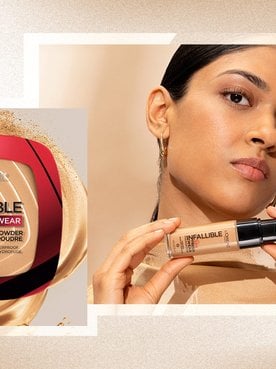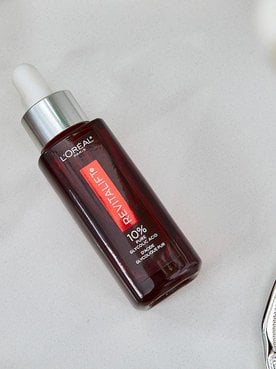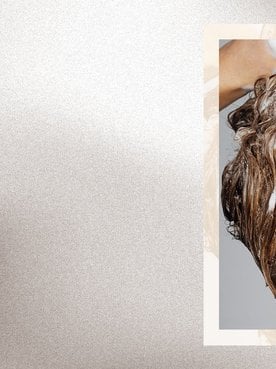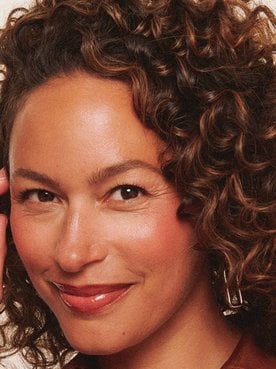Sun spots, age spots, liver spots—these terms all describe a type of discoloration that can occur after years of sun exposure. Though these flat, dark spots are typically harmless, they can make your skin appear dull or uneven. If you have them, you’ve likely wondered how to remove sun spots to restore your complexion’s youthful radiance.
Unfortunately, once a sun spot forms, it’s usually not possible to erase it entirely without in-office dermatological treatments. However, the right skincare routine can help soften their appearance over time. Below, we’ll explain why sun spots develop, go over a few different types of sun spots on the skin, and offer tips on the best ways to brighten, refine, and even your complexion—no pricey derm visit needed.
What Are Sun Spots?
According to the Mayo Clinic, sun exposure spots, also known as solar lentigines, are flat, discolored marks that can develop after years of unprotected sun exposure. They typically occur on the face, neck, chest, or upper back, but can develop on any sun-exposed skin. Anyone can get sun spots, but they’re most common in adults over 50 (especially those with fair skin).
While sun spots often look similar to freckles, they’re not quite the same thing. Freckles are often genetic and can fade on their own over time. Sun spots on the skin, meanwhile, don’t fade—once they’ve developed, only a targeted skincare routine or in-office treatments can reduce their appearance.
It’s worth noting that while sun spots aren’t dangerous, they can develop into more serious concerns over time. If you notice a spot that is growing in size, changing color, has irregular borders, or scabs and bleeds, schedule a visit with a board-certified dermatologist for evaluation.
What Causes Sun Spots On the Skin?
As the Mayo Clinic explains, sun spots are essentially your body’s way of protecting itself from excessive sun exposure. Each time your skin is exposed to UV rays, the pigment cells in your skin go into overdrive, creating additional pigment (known as melanin) to help protect your skin from damage. In the short term, this can cause your skin to tan or burn. Over time, however, it damages those pigment-producing cells, causing them to overproduce melanin. When this happens, a sun spot (or several) can develop. Note that despite the name, the sun isn’t the only thing that can lead to these discolored spots: tanning in a tanning bed is a common culprit, too.
What Are White Sun Spots?
Sun spots are typically pinkish, brown, or gray in color, but that isn’t always the case: Sometimes, they manifest as white spots. According to the Cleveland Clinic, these lighter spots are typically indicative of damage to melanocytes, the cells that produce your skin’s natural pigment. These spots often appear on the arms and legs and, like dark sun spots, aren’t usually cause for alarm. However, it’s still important to monitor your skin closely and check in with a dermatologist if you notice any changes.
What Are Red Sun Spots?
While red sun spots (also known as actinic keratoses) develop after years of sun exposure, they differ from white and brown sun spots in a few key ways. For one, they typically have a rough, bumpy, or scaly texture and may look like a rash or pimple. Actinic keratoses may also itch or sting and may bleed. Most importantly, however, is that the presence of red sun spots on the skin indicates a higher-than-average risk of developing skin cancer, per the American Academy of Dermatology (AAD). If you have scaly red patches or spots on your skin that you suspect may be due to sun exposure, visit your dermatologist. They can assess the spots and determine whether they’re benign or need to be removed.
Can You Prevent Sun Spots?
While you can’t prevent sun spots altogether (at least, not without avoiding the sun entirely), proper sun protection makes them less likely to form. Ahead are a few things that you can do to reduce your chances of developing sun spots on your skin.
1. Wear broad-spectrum sunscreen
To help prevent sun spots and other signs of skin aging (such as wrinkles), the United States Food and Drug Administration (FDA) recommends wearing a broad-spectrum sunscreen with an SPF of at least 15 every day. And yes, we do mean every day—UV rays can still damage your skin even if it’s cloudy outside.
To protect your skin and help fight the visible signs of aging all in one go, consider using an SPF moisturizer, like the L’Oréal Paris RevitaLift Triple Power Moisturizer with SPF 30. The non-greasy formula smooths, brightens, and delivers up to 48 hours of hydration while helping to shield your skin from damaging UV rays. Plus, it’s suitable for all skin types and won’t leave behind a chalky white cast the way some old-school sunscreens might.

2. Limit your time in the sun
Sunscreen only goes so far—you’ll also want to take additional measures to protect your skin from sun damage. For one, try to limit your time in the sun at midday, as this is when the sun’s rays tend to be most intense. It’s also a good idea to seek shade whenever possible when spending time outdoors.
On long, sunny days, cover whatever exposed skin you reasonably can, and wear a wide-brimmed hat to shield your face from sun exposure. Finally, always keep body and face sunscreen in your bag for reapplication—as the FDA notes, sunscreen should be reapplied at least every two hours (more frequently if you’re sweating or swimming).
3. Use a vitamin C serum
Exposure to UV radiation generates free radicals, tiny molecules that can contribute to oxidative stress and damage your skin. Incorporating an antioxidant into your regular skincare routine can help neutralize those damaging compounds, minimizing your likelihood of developing visible concerns like sun spots and wrinkles.
Though all antioxidants help neutralize free radicals, vitamin C is among the best—especially for anyone looking to brighten or refine their skin. To incorporate this powerful ingredient into your routine, reach for a targeted vitamin C serum, like the L’Oréal Paris RevitaLift 12% Pure Vitamin C + E + Salicylic Acid Serum. The daily-use formula brightens, evens, and refines the skin while helping to minimize the appearance of dark spots and pores over time. We recommend applying it to clean, dry skin morning and night, then completing your routine with a gentle, hydrating moisturizer.

Shop the Products
How To Address Existing Sun Spots
While sun spots don’t fade on their own, the right skincare routine can help minimize their appearance. Keep reading to learn how to brighten and refine your skin tone, plus how to get rid of sun spots with the help of a board-certified dermatologist.
1. Try a niacinamide serum
Niacinamide, also known as vitamin B3, is beloved by skincare enthusiasts for its ability to help brighten, hydrate, and soothe the skin. But according to the Cleveland Clinic, it can also help minimize the appearance of dark spots.
You can incorporate this multitasking ingredient into your routine with the L’Oréal Paris Bright Reveal 12% [Niacinamide + Amino Sulfonic + Ferulic Acid] Dark Spot Serum. The concentrated formula helps diminish the appearance of dark spots (including sun spots and post-blemish marks) in as little as one week, while continued use leaves the skin brighter, clearer, and more luminous.

2. Look into lasers
If you’re eager to see results, many in-office treatments can reduce the appearance of sun spots quickly. Laser facials, such as fractionated lasers and intense pulsed light lasers, are among the most popular. These treatments can help target the discoloration deep within your skin to reveal a more even complexion in as little as one session. The downside? They’re not cheap—depending on the type of laser your technician is using, you can expect to pay anywhere from a few hundred to over a thousand dollars per session. If you decide to take the plunge, be sure to follow your technician’s aftercare instructions to ensure your skin heals as it should. You can also incorporate a brightening moisturizer, like the L’Oréal Paris Bright Reveal Vitamin C Glow Moisturizer, into your routine to help maintain a luminous, fresh-faced complexion.

3. Consider a chemical peel
Lasers aren’t the only professional treatment that can help fade sun spots. Chemical peels can be effective, too, provided they’re applied properly. Usually, these treatments involve applying an exfoliating acid to the skin to encourage skin cell turnover. The acid is then neutralized or removed, revealing a fresher, more even-looking complexion.
Chemical peels are generally more budget-friendly than lasers, but still require scheduling an appointment with a dermatologist or aesthetician. If you’d rather address your skin concerns from the comfort of your own bathroom, try an at-home peel like the L’Oréal Paris Bright Reveal Dark Spot Peel. This professional-inspired formula features a trio of exfoliating acids (AHAs, BHAs, and PHAs) and works quickly to help fade stubborn dark spots and discolorations. It brightens and retexturizes the skin in a single use, and after two weeks of consistent use, you’ll notice a dramatic improvement in your skin’s texture and tone. Because it’s a potent formula, this at-home peel isn’t meant for daily use—we suggest applying it no more than four times per week (at night) to revive your complexion. Be sure to double up on your sunscreen the next day, as exfoliating acids can make your skin more sensitive to the sun’s damaging rays.
Shop the Products
How To Choose the Right Treatment for Sun Spots
Skincare isn’t one-size-fits-all, and that’s especially true where discoloration is involved. To avoid irritating or damaging your skin, it’s important to choose a dark spot treatment that aligns with your skin’s unique needs. A board-certified dermatologist can help you decide which approach is best for you, but here are a couple of things to consider.
1. Your skin type and tone
Your skin type and tone play a significant role in determining which approach is right for you. For example, chemical peels can be highly effective at minimizing the look of sun spots, but they may be too aggressive for those with highly sensitive or reactive skin. Likewise, while many lasers can help minimize the look of dark spots, those with deeper skin tones should exercise caution, as some lasers may make discoloration worse. Always consult a board-certified dermatologist before proceeding with any in-office treatment.
2. Sun spot intensity
If you only have a couple of sun spots you’re hoping to fade, a proper at-home skincare routine (and a dedication to SPF) should be enough to achieve your skincare goals. On the other hand, if you have extensive sun damage, a more intensive treatment—like a series of laser facials—may be warranted. Again, your dermatologist can help you determine which approach is right for you.
3. Budget and downtime
As we mentioned, in-office treatments can be pricey, with lasers typically costing hundreds of dollars per session (even chemical peels will generally run you a couple of hundred dollars per session). Additionally, many in-office treatments require a day or more of downtime, which can add to the overall cost of the treatment. If budget is a concern, taking a slow-and-steady approach with a targeted at-home skincare routine may be the better option. Ultimately, though, it’s up to you—take stock of your needs and goals and speak with your dermatologist to determine how best to care for your skin.
Next Up: How To Get Glass Skin: 15 Tips To Try
Photo courtesy of L’Oréal Paris







